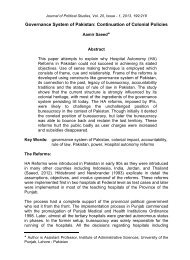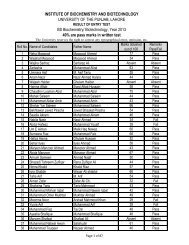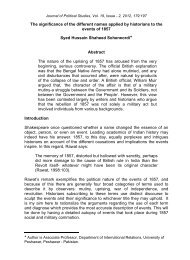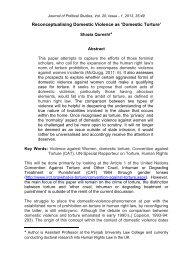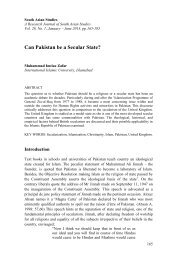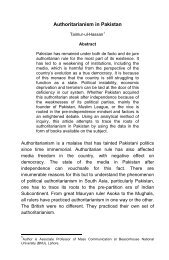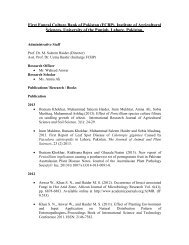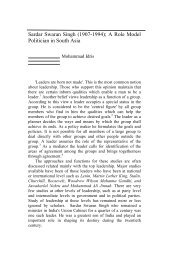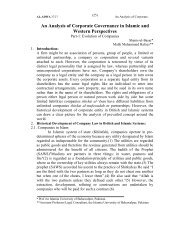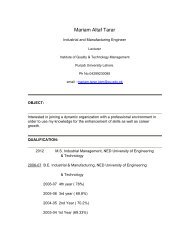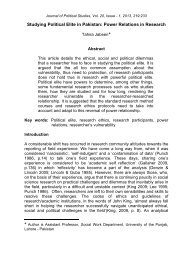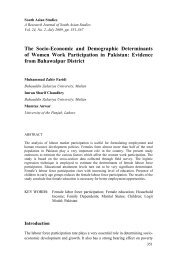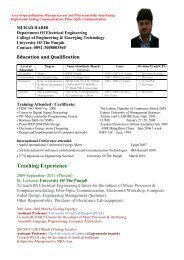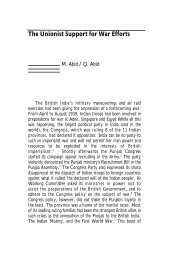pakistan geographical review 1954 - University of the Punjab
pakistan geographical review 1954 - University of the Punjab
pakistan geographical review 1954 - University of the Punjab
You also want an ePaper? Increase the reach of your titles
YUMPU automatically turns print PDFs into web optimized ePapers that Google loves.
On <strong>the</strong> whole factories are few in <strong>the</strong> Levant coastal countries. A big miil has<br />
been establi shed in Tripoli (Syria) and is producing medium quality cloth.<br />
There is a silk reeling and weaving mill at Beirut [Labanon). Horns and Hama<br />
produce cotton and silk mixture cloth after Arab fashion. Modern cloth for<br />
everyday use is improted. In Palestine Jewish textile mills have been established<br />
at Haifa and Tel-Aviv. An Arab mill has also been erected at Gaza.<br />
None <strong>of</strong> <strong>the</strong>m has more than 50 looms.<br />
CEMENT<br />
-INDUSTRY<br />
In all <strong>the</strong> Middle-East countries, <strong>the</strong>re is 'an abundance <strong>of</strong> limestone,<br />
marl and gypsum-raw materials lor cement manufacture. 'Except Afghanistan,<br />
Jordan and Arabia, all-o<strong>the</strong>r countries prepare cement for- home needs. Turkey<br />
Egyp: and West 'Pakistan are almost self -suffiiient in this respect. Expansioan<br />
in this industry is-a resulrs <strong>of</strong> pilit ical events and social uplift e.g. Egypt had<br />
boom year 'in cement industry in 1'946 to meet '<strong>the</strong> demand <strong>of</strong> <strong>the</strong> allied<br />
military authcr'ittes. Itsoutput rose from 350,'O(f0 tons ill 19'39 to 590,()00 t01\S<br />
in 1'9'46. Presentaumral production is 650,000 tens <strong>of</strong> which small quantit-ies 'ar-e<br />
export edto<br />
Sudan,<br />
Turkey has five factories each producing 400,000 tons. In <strong>the</strong>se mills<br />
Government share is 28%, one rest have private. Iran has one factory at<br />
Tehran which-is-state owned. .Peak production was in 1946-200 tons per day.<br />
West ..Pakistan -has three factories -at W ah, Dando t and Karachi -and to ta!<br />
producticn is 1-300,00(9 tens <strong>of</strong> cemen t -and eerrrent .produets. Thereis-a newly<br />
insta-lled cement factory in Iraq, sponsored by th-e Indus! rial Bank. In 1952, its<br />
capacity had been doubled for h-eme needs. Syr iav-Leb anon 'and Palest iae have<br />
'Only cement tile and brick kiln, though cement factories are being planned.<br />
CHEMIcAi<br />
INDUSndES<br />
The industry requires high technical ability, which is generally lacking<br />
in <strong>the</strong> Middle East. Consequently, inspite <strong>of</strong> <strong>the</strong> fact that mineral salts are<br />
found, development is restricted as it also needs complementary developmen ,<br />
in o<strong>the</strong>r industries, creating a demand for chmical products. As <strong>the</strong>se countries<br />
are primarily agricultural a major part <strong>of</strong> this industry is engaged in <strong>the</strong><br />
preparation <strong>of</strong> fartilizers, production <strong>of</strong> course is limited because <strong>of</strong> <strong>the</strong> fact<br />
that agriculture is nei<strong>the</strong>r modern nor mechanized, Turkey having taken to<br />
industrialization earlier leads in <strong>the</strong> production <strong>of</strong> chemicals. Some 18,000 tons<br />
<strong>of</strong> sulphur ic acid 16,000 tons <strong>of</strong> fertilizers, 4,448 tons <strong>of</strong> super-phosphates and



